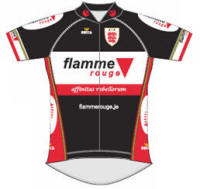Just In Time Base Building
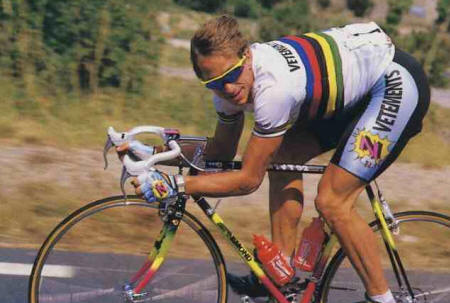
Greg LeMond World Champ building base
TVT 92 a Classic Bike ~ check out that stem length
Base building? We all need to do it, because I'm sure you realise you can't reach a training peak without it. The old adage was, "You can never have enough base. The deeper the base, the higher the peak".
But how hard should base riding be? When have you built enough base? When do you transition from "base" to "training"? As ever, loads of questions, and as ever, it's the same answer to all of them. It depends.
So here we are again, turning things on their head. Here's my alternative view on Base Building. But before you start, what about a test to validate your aerobic efficiency?
As usual, we're going to be challenging mainstream thinking and propose something different for you. But first off, I'm going to reach back in history to see where the original base building thoughts came from and how they have evolved in to what they have become today.
So, open your mind and dive in. But if you want to miss the preamble and go straight to my "Parallel Training" concept, follow this link...
How It's Done Today
Base building is steeped in the tradition of cycling clubs around
the world, passed down through the generations. Previously, it was a huge
dose of what was known as, LSD;
Long, Slow, Distance. Riding for hours on end, for weeks on end,
at a constant, controlled, "smelling the flowers" pace.
As we entered the nineties, people became impatient and the "slow" morphed in to "steady". So for a decade, it became Long, Steady, Distance. Still LSD, but the dynamics were beginning to change.
Since the millennium, mainly due to the influx of newer riders who missed their "apprenticeship", the loss of strong peloton patrons, road captains and club structures, the steady pace has been perceived as the new "slow". Therefore, the pace again picked up, to what we have now.
Over the last twenty years, pace has gradually increased from "slow, to steady, to tempo". While no one was paying attention, LSD became LTD.
 Most
riders understand that base is a price that has to be paid.
Base is what the
pro's do, so base is what we need to do, to be good riders. Which, to a point, is correct.
Most
riders understand that base is a price that has to be paid.
Base is what the
pro's do, so base is what we need to do, to be good riders. Which, to a point, is correct.
But pro's do LSD, not LTD. And to be brutally honest, when was the last time you raced for five hours a day, a 100 days a year, from February to October?
The fact that the pace is now generally too high on most club runs, doesn't register with most riders as it's all they know. People have got things to do, places to go, riders to drop.
Extended base building is seen as a traditional, seasonal, right of passage. So everyone does it, even if they're not pro's and even if they don't fully understand why. I even used to do it myself.
But then I got thinking; which for me, is always dangerous...
Paralaysed Training
One of the main challenges I face with new riders is breaking the cycle of ambiguity I call
Parallax Training. It's not a good
thing, so don't try to remember the phrase.
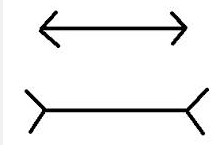 Parallax Training; where
the fast riding is too slow and slow riding is too fast.
Parallax Training; where
the fast riding is too slow and slow riding is too fast.
It's a classic case of "proactive inertia". A term I used in a previous life to describe people who are busy doing nothing, but who feel "productive".
It's all comes down to perspective. The same object, presented with subtle differences, can produce two completely different outlooks.
The two lines above are exactly the same length. The view presented of them is skewed by extraneous, extrinsic information. It's the same with base speed. Even though it may be the same speed being considered, an unknowledgeable rider's slow, is a knowledgeable rider's fast.
Because of this, riders often end up riding their base in the lost world; the world of doldrummic Zone Three. A pace that's hard and fast enough to burn energy and feel like training, but not hard or fast enough to elicit a specific, or worthwhile, training adaptation.
Most club runs fall in to three to four hours of Zone Three Tempo. In the last twenty years, I've seen literally thousands of power files from riders around the world that support this premise.
If everyone is doing it then it's not an issue. You're not going to be any slower, or faster, than your club mates. But this is how clubs have operated for decades; excellence through exclusion.
Everyone rides the same pace, until they're dropped. All variables minimised, the guardians of the cult reinforce their legend and bask in their magnificence.
Big Brother Training; it was okay in 1984, it doesn't fit today's lifestyle.
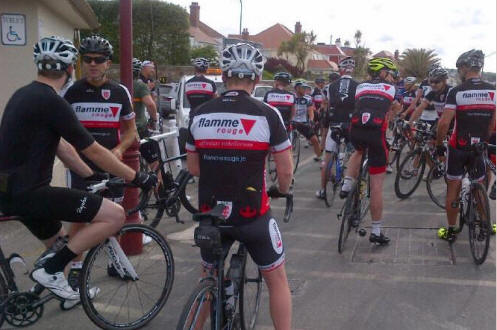
The Gunsite Grupetto ~ briefing before the off
Getting the "training not racing" message across
Diff'rent Strokes
Our Gunsite Grupetto sessions are different and can cause confusion
for the uninitiated or weak willed.
It often takes a while to build the confidence to leave groupthink
behind and abandon the safety of the herd. But once you do, it's
really quite liberating.
Either go slow or go fast; go easy or go hard; do it properly or don't do it at all. There is no in-between.
It's important to recognise the differences between slow-and-steady, and steadily faster, to prevent you falling in to the chasm of mediocrity that can be Zone Three Tempo Land.
It's really hard to get the levels right, especially if you're not used to them. So the golden rule on the flamme rouge rides is, if we're not going dizzy with effort, we're riding at 25 kph (16 mph) or less. Full on or full off. It's that simple. But people still have problems adapting.
I'm often heard screaming from the back of the group (we have a no shout rule, but we don't have team radio's yet) that the pace is getting too high. Often the speed indiscernibly creeps over 30 kph and starts heading for 35kph (22 mph) and above.
For some, it's hard to get their head around going for a two hour ride and only covering 50 kms. If you've not done 80 k, or 50 miles, in a two hour group ride, how can that be training?
Normally it's the young bucks on the front, either half-wheeling each other, or thinking that everyone's judging them for going too slow.
That's the point! It's not called "Smelling the Flowers" or "Village Policeman Pace" because I like the phrases. They're descriptions, not made up names. When you're recovering at Level One, or Base Building at Level Two, you should have the feeling of being slightly embarrassed when your mates see you. It's that slow.
Lecture/rant/infomercial over; although it may resume later. Anyway, that's the pre-amble and scene setting out of the way. Let's get to the business in hand...
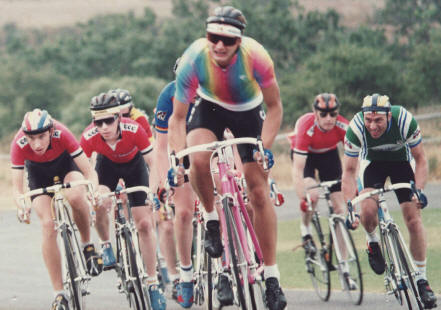
Yep, that's me in my "alternative kit, on my
alternative bike"
Notice how we all rode with white bar tape in "those days"...
The Thousand Mile Law
In the good old days (the mid-80's and probably the 50 years
before that) after the race season, we all took a couple of weeks
break before starting the steady social rides through the autumn and
in to the winter.
A fancy dress Boxing Day time trial would finish off the social season and "training proper" would start on January 1st, with the New Years Day Club Run. Just to see who, after the previous night's shenanigans, had the commitment to start their new season bang on cue.
The grandees of the club would control the pace, distance and route. We didn't know it then but this was Zone Two riding; as discussed above, we called it LSD. You did this for a thousand miles. If you were found to be going fast before the end of this period, people laughed at you as a misguided fool! Competition was seriously discouraged.
Once you had a "grand in the bank", the weekend runs progressed to Tempo (now Zone Three) and the distance picked up. You were now allowed to "sprint for the line" at the end of ride cafe stop! It was time to feel like a racer.
At the end of the second thousand miles we had the Reliability Trials, or sportives as they're now known in the UK. Then we progressed to the first two races of the season, which were on restricted gears, to encourage souplesse.
Finally came the standard fare, Easter Stage Race, to bring on proper fitness. Then the season started. Where we used to race ourselves fit at the weekends, and use the mid-week intervals/chain-gangs to build speed.
Life was so much simpler in those days. You knew were you stood. Sadly, some are still standing there.
So we have two schools of thought. Ride slowly (proper slowly) for two thousand miles, or ride tempo for weeks on end, building the speed and distance each week, until no one is left at the end of the ride.
How it Worked...
Here we have a traditional,
old-school, twenty week run up to the start of the season.
Twelve weeks of nothing but an increasing volume of base building.
Followed by eight weeks of "base-tempo" with a little intensity making up some of that extra
volume.
The Westell & Evans book of the 80's, Cycle Racing (it, along with Eddy Boryseywicz's, Bicycle Road Racing, were our bible's), extolled the virtues of January base riding as being, Tuesday, 2-3 hours steady; Thursday, 2-3 hours steady; Saturday 3-4 hours steady; Sunday 4-6 hours, steady. Twelve hours a week, all at the same, s-l-o-w, steady pace.
February was more of the same, but at a slightly higher pace so you went further for the same saddle time.
March saw the introduction of bursts of speed with the evening chain-gangs; two hours of full gas with our Wonder lights, that had a battery life of 90 minutes! This is what we knew, so this is what we did.
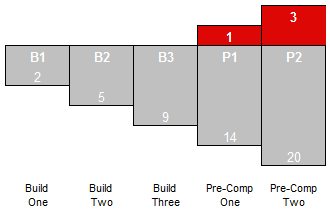
For clarity, I've used "our" micro cycle terminology to aid comparison later in the factsheet. We didn't have these terms back in the day...
The above chart shows how prior to the season start, we had constructed twenty blocks of grey base, to support just three blocks of "red pyramid". A 15% return on our winter training effort. But it's what we all did, no one was disadvantaged, so this was good.
The 80/20 Law
Now you've heard me bang on about this for years and you'll see it
peppered around the site. Eighty-Twenty (as with my Parallax
concept) is a throwback to the dark side of
my life spent in the corporate consultancy wilderness. Still, it bought us a house, so let's
not knock it!
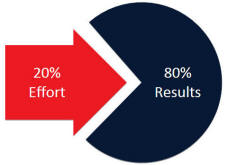 As a quick recap, generally, 80% of the returns come from 20% of
the effort. Which means the last 20% increase in performance
requires a further 80% effort to produce it. The law of
diminishing returns.
As a quick recap, generally, 80% of the returns come from 20% of
the effort. Which means the last 20% increase in performance
requires a further 80% effort to produce it. The law of
diminishing returns.
Half of my life has been spent trying to do more with less. The other half, questioning everything. I was a nightmare at school and have got little better in the following forty years.
Everything can be improved. Everything can be made better, simpler, faster. Everything. In the 90's I spent some time in the company of Tony Barnes from the Kaizen Institute, he taught me a lot about this stuff and how you should never be complacent. Never!
Especially in cycling! Sky now call it marginal gains. The Japanese invented it, in the late 1940's after WWII, Deming brought it to the West; with Tony Barnes. So this info has come first hand, from the man himself.
During these chronologically-challenged times in which we now live, we need to maximise our returns for the time we spend doing what we do. So riding around for hours on end during the week, to clock two thousand, pre-season, miles, in Zone's Two and Three, is out of the question.
Remember in the 80's there was no internet, no mobile phones, no 24 hour TV and no Sunday shopping. We had a lot more available, disposable, time. We now live in a world where the pace of change is outstripping our ability to cope. Those carefree, time-rich, days are gone, never to return.
So what do we do now?
A New Perspective ~ Parallel Training
Parallel Training
There has to be an alternative. And to present it, we'll use
cycling's age old analogy for building base, that of building a
house.
Old school thinking (as above) suggested, that if you want to build a house you have to put all the foundations in before putting up the downstairs walls, the upstairs walls, and then the roof on. This is how old-school base was built. Dig a bl**dy big hole, see nothing for your efforts for months, then construct your building on top.
But what if you're building a sky-scraper? What if you're going to build something nine stories high? Do you need to build a hole nine stories deep before you start? Not in my world!
Our programmes build base and intensity, in parallel. Parallel Training, not Parallax Training. You can remember that phrase if you wish!
Your base only needs to be deep enough to support the intensity you are expecting to apply in the period you are currently in. And if you're an experienced rider, you will carry forward your base from previous years so have less of a hole to dig in the first place.
Our programmes, almost from the off, layer intensity in to the base period. Only small amounts to begin with, but enough to fire up the metabolism, build strength and prepare the body to support the bigger efforts to come later in the programme.

As each week and month passes the intensity increases at a rate that's supportable by the underpinning base. You are always building a support structure that's just-in-time and fit for purpose.
The genius of its simplicity is not lost on a simpleton like myself. Why make things more complicated than they need to be?
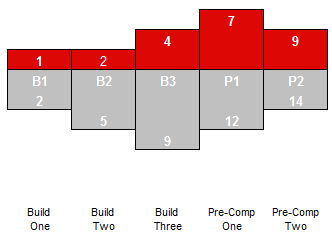
This chart, shows the flamme rouge method. You are still building a base foundation for most of the time, but you also simultaneously build a course of bricks above ground.
Initially, the cumulative base is always double that of the intensity. When we get to the Pre-Comp Phase, the depth of base, and the strength of your developed reserves now allow base to be cut back. We then cut volume back to allow for a physiological rebound just as the season starts.
Each month you actually see a reward for your efforts and feel yourself getting fitter, faster and stronger.
The ongoing increased fitness allows you to raise the volume of your subsequent training in the next micro cycle. Again, increasing metabolism, helping weight control and making the whole training experience more positive and enjoyable.
The only caveat is; when you aren't "doing intensity" you ride so slow, it's embarrassing. Full on, or full off. There is no in-between.
It isn't easy by any means, and it's not for everyone, but boy does it work!
 Side
by Side Comparison
Side
by Side Comparison
As you can see in this chart, using our method, prior to the season start,
gives you fourteen blocks of grey base, to support
nine blocks of "red pyramid". A
whopping 64% return on your winter endevours.
As long as you back off just before the season start, to allow adaptation and freshness to accrue, you hit the ground running on day one of the season.
As you are still "fresh" mentally and physically, you have more than enough room to increase your peak as the season progresses so there's no risk of overtraining, a plateau, or staleness.
Our training programmes, and this method, rely on discipline; knowing the difference between slow, tempo and fast, and stressing the right parts of your physiology, in the right order, for the right amount of time.
It also requires regular scheduling of dedicated recovery/adaptation weeks. These are key to the success of the programme, or any programme for that matter, and should be given the same attention and dedication as that applied to any of your "training" weeks.
So there you have it. Twenty three training blocks in each programme, but vastly differing returns on your training investment.
How It Works
It was once though that to have a high anaerobic capacity you had to
first increase your aerobic base. And to some extent that's
still true.
But sports science knowledge has increased so much in the last ten years, never mind the last thirty, that we now know an awful lot more about how the body works than we used to.
As we've discussed elsewhere, cycling is all about getting the oxygen from outside your body to inside. This requires the co-operation of many physiological functions. Mainly centered around the lungs, blood, heart and muscles.
Riding at Zone Two is good for increasing your mitochondria, but Zone Three is better, and Zone Four is best. So why ride around for four hours in Zone Two when twenty minutes of Zone Four, once a week will give you the same effect?
 It's
the same for increasing plasma volume and cardiac output. Why
wait until the season start to work on increasing the elements that
can help get blood and oxygen around the body quicker?
It's
the same for increasing plasma volume and cardiac output. Why
wait until the season start to work on increasing the elements that
can help get blood and oxygen around the body quicker?
A bigger, more efficient heart, that shifts more oxygen and blood per beat, will obviously help you go faster, for longer and recover quicker. How can it not?
Get this done before you need it, and allow greater adaptation to take place sooner, rather than always being behind the curve.
You don't need to spend hours a week doing intensity. That will just lead to burn out. Just sprinkle a little Zone Three and Zone Four into your build phase and a little Zone Four and Zone Five in to your Pre-Comp. No more than an hour cumulative effort in to a ten hour training week.
The Message
As with all things sporting, cycling or life in general, there are
as many opinions as there are people to give them. I'm just
firing an alternative view here that works for me and for many
thousands of cyclists around the world.
As most of you know, I live on a tiny island. But for the last ten years, along with my wife Dianne, I've travelled Europe taking on some of the biggest sportives, their best championships and the highest mountains.
With a lap of our island taking around an hour and a half, I had to find an alternative training solution just to keep my sanity. And it all started with finding an alternative to riding around, building a base.
So think differently. Don't keep doing the same thing and expecting different results; it only leads to disappointment. Spice up your base training and reap the rewards sooner rather than later.
What have you got to lose?
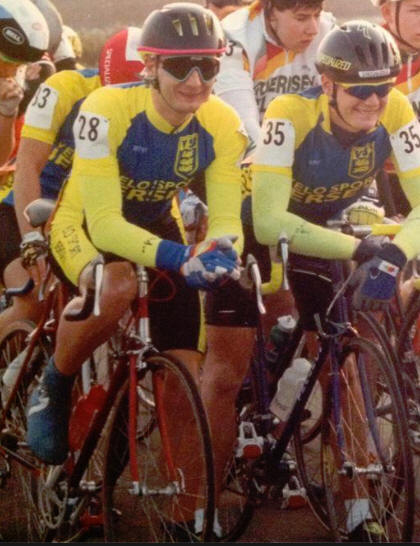
Finalising fitness ~ Guernsey Easter Stage Race
1989
On the start line with my glorious LeMond-like TVT 92 & Factory Pilots
Before this happened to it...
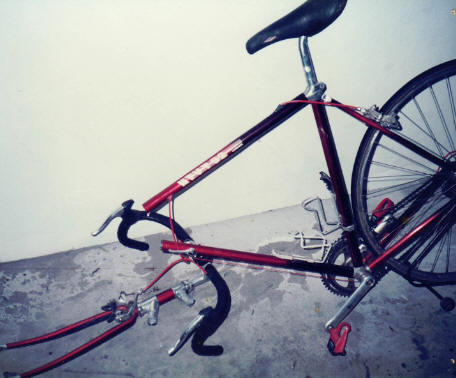
not a good day at the office...
I still carry the scars thirty years later

